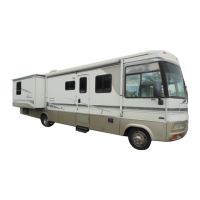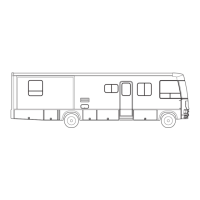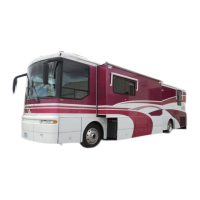SECTION 4
TRAVELING WITH YOUR MOTOR
4-2
To determine the weight on either front or rear
axle, drive that axle only onto the scale. Neither
axle weight should exceed the corresponding
maximum axle weight rating specified on the cer-
tification label.
MAXIMUM OCCUPANCY
The following label is placed in a visible
location in the driver compartment.
The number of belted seating positions in
your motor home may exceed the number people
used to determine maximum coach occupancy,
called the Cargo Carrying Capacity (CCC).
To calculate the CCC, Winnebago uses vehi-
cle sleeping capacity, however your coach may
be equipped with more belted seating positions
than sleeping positions to give passengers a
choice of seating arrangements. You may use all
of the belted seating positions providing you
stay within your vehicle’s GVWR listed on the
Vehicle Certification Label (see page 0-3). How-
ever you use or load your vehicle, it is your
responsibility to keep the weight within its stated
gross vehicle weight rating.
ROOF LOADING
The roof is capable of carrying some light-
weight articles while the vehicle is in motion. A
roof-mounted luggage carrier designed for this
purpose is available from your dealer. However,
roof load while the vehicle is in motion is not to
exceed 10 pounds per square foot or a maximum
of 100 pounds.
When the vehicle is stationary, a cargo load of
100 pounds plus the weight of a 225 pound per-
son to load the cargo or to conduct inspection and
maintenance is permissible.
Weight added to both the roof and the trailer
hitch contribute to the gross vehicle weight,
which must not exceed the vehicle’s GVWR.
CAR OR TRAILER
TOWING
Ford or Workhorse Chassis
Hitch pulling cap.: 5,000 lbs. max.
Tongue weight: (Ford) 350 lbs. max.
Tongue weight: (Workhorse) 500 lbs. max.
The factory installed towing hitch on this
coach is capable of pulling a 5,000 lb. load
(max.), however the vertical (tongue) weight may
vary according to chassis and model combina-
tions. Also, your coach’s towing and hitch ball
(tongue) capacity may be reduced if the com-
bined loaded weight of the coach and the towed
vehicle exceeds the GCWR (Gross Combined
Weight Rating) of the chassis.
The combined weight of the coach and the
towed vehicle should not exceed the coach’s
Gross Combined Weight Rating (GCWR). Also,
the combined weight of the coach and the towed
vehicle’s hitch ball weight should not exceed the
coach’s Gross Vehicle Weight Rating (GVWR)
or its rear Gross Axle Weight Rating (GAWR)
listed on the Vehicle Certification.
Because of individual vehicle use and loading
habits, we recommend weighing the vehicle
while fully loaded to avoid exceeding any of the
listed Gross Weight Ratings. See “Vehicle Certi-
fication Label” on page 0-3 for information on
gross weight ratings.
Towing will affect vehicle handling, durabili-
ty and fuel economy. Exceeding any of the listed
Gross Weight Ratings will result in unacceptable
overall vehicle performance. Maximum safety
and satisfaction when towing depends on proper
use of correct equipment. A hitch bar of appropri-
ate steel and size should be selected to mate with
the factory towing receptor.
BELTED SEATING POSITIONS MAY
EXCEED SLEEPING CAPACITY OF
THIS VEHICLE. SEE OWNER
MANUAL FOR OCCUPANCY AND
WEIGHT RESTRICTIONS.

